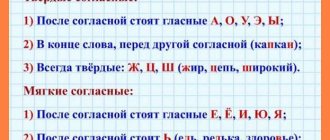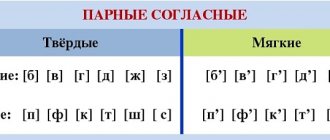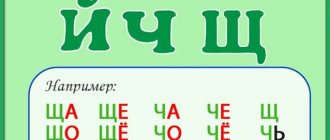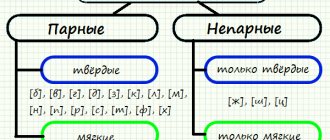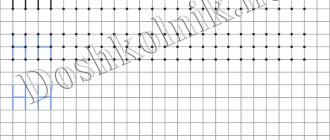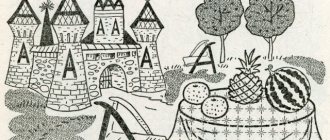Nowadays, many people show interest in their past, including the history of their family. Interest in this topic did not arise by chance: the idea of oneself as a person has changed. If earlier a person was part of a system, today he is, first of all, an individual. Therefore, the question of where I and my ancestors are from is very relevant.
You can, oddly enough, slightly lift the veil of secrecy by studying the rules of the Russian language and the letter “C”. Why, for example, is it written “Yeltsin”, but “Solzhenitsyn”, if, according to the rule, “I” follows “C”, with the exception of a few words. It’s simple: this law does not apply to the writing of surnames, since they were entered into the passport in accordance with the pronunciation that existed in the territory of the person’s residence. In Ukraine it was considered correct to write “TSI”, and in Russia - “CI”. From which it becomes clear where, whose ancestors are.
Sound and noise
The number of consonant letters in the Russian language is 21. One part of them is pronounced with the participation of voice and noise, and the other - only with the participation of noise. Accordingly, the first part refers to voiced consonants, and the second, accordingly, to voiceless consonants.
The next characteristic by which consonant letters are divided is hardness and softness, which depend on the vowel letter following the consonant in the syllable.
- If you try to shout out the letters: k, p, s, t, f, x, c, w, then you will have difficulties, since their articulation does not involve the participation of the voice: all these letters are voiceless. Elementary school teachers suggest memorizing the sentence: “Styopka, do you want some bacon? Fi!”, which contains the entire set of voiceless consonants. But they are wonderfully pronounced in a whisper.
- But you can easily shout out the letters: b, c, d, d, g, z, j, l, m, n, r, since their pronunciation involves sound vibrations formed by ligaments and changed through articulation. These are voiced consonants. But if you try to whisper them, you won’t succeed.
In colloquial speech, voiced and voiceless consonants can be pronounced almost identically: live - sew; goal - count; day is a shadow, but their meanings do not coincide.
How to distinguish a hard and soft consonant?
To find out whether a consonant is hard or soft, first pronounce the word and listen to how the sound being studied sounds:
- in ar [v] - in ilka [v']
- sign [z] - basket [z']
- with om [s] - with gray [s']
- x good [x] - x itry [x']
Let’s also take into account that in written speech the consonants after which the letters are written are soft:
- white [b' e l y']
- motley [p' o s ry y']
- sled [s a n k'i]
- glass [r' u m k a]
- lethargic [v' a l y']
2. The softness of many consonants, except for the unpaired [zh], [sh], [ts], [h'] and [sh'], expresses “b”:
- big [l']
- seven [m']
- tablecloth [t']
- fight ba [r'].
Let us take into account that “b”, which is written after the always hard hissing “zh”, “sh”, does not serve to soften them, but to denote feminine nouns of the third declension or verb forms:
- tremble [f]
- gouache [w]
- eat eat [w]
- zama [zh]
- don't worry [f].
3. Consonants in a combination of several sounds can be soft in sound if the subsequent soft consonant influenced the previous one. This phonetic process of softening a consonant depending on its position in a word is called assimilation based on hardness/softness, or assimilation (Latin assimilatio - “likeness”).
Let's see how consonant sounds influence each other:
- pen n siya [p' e n' s' and y' a]
- bathman [ba n' sh' i k]
- donut [p o n' h' and k]
- illness [b a l' e z' n']
- ko s ti [k o s' t'i]
Please note that this phonetic sound of soft consonants is not reflected in written speech.
In accordance with the spelling rule, a soft sign is not written in conjunction with the consonants nch, chk, chn, rshch, rch, etc.
Soft consonants are scientifically called palatalized .
When soft consonants are formed, in addition to the main articulation, the participation of the hard palate is added. The Latin for “hard palate” is palatum, hence the name “palatalized.” The phenomenon of softening is called "palatalization".
How to determine which consonant is soft and which is hard?
As you know, the consonants Ch, Shch, Y are always soft in the Russian language.
In other cases, a soft consonant can be identified by the letter that follows it.
Typically, a consonant letter will represent a soft consonant sound if it is followed by one of the following six letters: E, E, I, Yu, I, b .
forest (L soft), dog (P soft), view (B soft), ruffle (R soft), mint (M soft), horse (N soft).
But you need to be careful:
1) The consonants Ж, Ш, Ц are always hard! They will never soften, even in front of I or E.
2) In some foreign words, the consonants before the letter E are not softened. Unfortunately, there is simply no universal rule in this regard. For example, text is pronounced, but tEst, TEMP; despot, however damper; Nerve, however vonEma. So here you just have to cram and memorize every word.
3) If after a consonant there is a soft consonant, then the preceding consonant may soften, but may remain hard. The following rules can be formulated:
a) the consonant N is softened before soft T, D: bow, undine. In addition, the letter N is always softened before Ch, Sh: lemon, racer.
b) the consonants T, D are softened before the soft N: worker, rider.
c) the consonants S, Z are softened before soft T, D, N: bridge, idleness, songs, fuss. (Before other soft consonants, the letters S and Z do not soften! Laughter is S hard, vision is Z hard.)
In other cases, consonants before other consonants usually remain hard.
I would like to summarize the above answers. In the Russian language, there are consonants that are always hard (Zh, Sh, Ts), always soft (Ch, Shch, Y), while the rest can be both hard and soft, depending on what sounds are their “neighbors” on right.
- If after a consonant there is a hard consonant, then the sound being identified is hard (this is if you do not take into account assimilation, when sounds are likened to each other)
- there is an exception to this point: the letter N softens before the soft D, T and the sounds CH, Sh; and vice versa, D, T are softened before the letter N. Z, S are also softened before soft D, N, T.
- If there is a vowel after a consonant sound, hardness and softness are determined by these sounds
- Softens consonants and a soft sign (its second function is the separation of sounds).
To indicate soft consonants in a word, and such a task is offered in tests about the Russian language (“Indicate words with all soft consonants”), you must immediately discard the always hard sounds zh , sh , ts , for example:
in the word ginseng , despite the apparent softness (the presence of the letters “e” and “b”), there are actually two hard sounds. This word is not suitable as a correct answer.
We also remember about always soft sounds: ch , sch , th .
And all other consonants can be either soft or hard. They immediately soften if they are followed by the letters: e , e , yu , i , and , b , for example:
doe , change , row , flax , cradle , fox , bark . _ _ _
And sometimes, despite the absence of a soft sign after a consonant, all the sounds in it are still soft due to the interaction of sounds with each other, when one soft sound softens the previous one. This phonetic phenomenon is called assimilation by softness . In the word “nurse”, at first glance, you cannot immediately determine whether all the sounds are soft. But if we listen to its sound, we will hear this:
- Registration
- Entrance
—Categories
- sewing (627)
- clothing and wallpaper patterns (252)
- artists (209)
- illustrations (206)
- felt, textile (199)
- dolls (193)
- decor (189)
- toys (176)
- postcards, etc. (147)
- rag dolls (146)
- useful for home (138)
- modeling (133)
- doll toy patterns (132)
- puppet masters (112)
- scrap (110)
- fairies, princesses, tildos (105)
- cold porcelain (98)
- for rollers (94)
- fashion. ideas. decor (92)
- drawings, stamps, etc. (91)
- from ribbons (89)
- hairpins=elastic bands=headbands (77)
- paper, cardboard = ideas (66)
- dresses, sundresses (65)
- alterations (64)
- bags, pencil cases, purses, organizers (63)
- decor of jars, boxes, bottles, etc. (52)
- painting (50)
- sew for kids (49)
- salt dough (48)
- tools. recipes for cotton, steel, chalk, etc. (46)
- New Year's Christmas (45)
- organization of work space (40)
- pillows, blankets, rugs (35)
- developers (34)
- sweaters, tops, tunics, blouses, shirts (33)
- wandering through other people's diaries (30)
- health (29)
- decoupage (29)
- recipes (29)
- shoes (28)
- cosmetics (28)
- trousers and skirts (27)
- copybooks, cards..coloring books (24)
- applique (21)
- my works (20)
- doll accessories (18)
- textile fantasies (14)
- papier mache (14)
- coffee toy (13)
- beads (13)
- interior (12)
- from newspapers (11)
- coats, jackets, ponchos, raincoats (9)
- paper art (9)
- Boho chic (9)
- Gallarda (8)
- upbringing. relationships (8)
- for applications (7)
- hats. hats. scarves. ponamki (7)
- drawings for beads (7)
- tags (5)
- decorative panels (4)
- owlmania (3)
- Saturated Canary (3)
- buttons (2)
- quilt (1)
-Video
-Music
—Search by diary
—Subscription by e-mail
—Interests
— Regular readers
—Communities
-Statistics
LEARNING TO READ. CARDS - HARD AND SOFT CONSONANTS
Learning to read.
Cards - hard and soft consonants
In continuation of the post “How to teach a child to read by syllables? Making words from syllables” I offer you new material - cards with hard and soft consonant sounds.
Use cards to teach your child to determine when consonants are soft and when they are hard.
Blue - solid
Green - soft
Consonant sounds can be soft or hard. For example, in the word “world” you hear a soft consonant zyuk [m’], and in the word “poppy” you hear a hard consonant sound [m]. The softness of a consonant is indicated by adding the symbol ' to its notation, for example: [m'].
Always soft sounds: [th'], [h'], [h'].
Always hard sounds: [zh], [sh], [ts].
The remaining sounds are soft if they are immediately followed by the vowels e, ё, i, yu, я or ь, and hard if they are followed by other vowels and consonants.
Hard and soft consonants differ in the position of the tongue.
When pronouncing soft consonants ([b'], [v'], [d'], [z'], etc.), the entire body of the tongue moves forward, and the middle part of the back of the tongue rises to the hard palate. This movement of the tongue is called palatalization. Palatalization is considered an additional articulation: it is superimposed on the main one associated with the formation of an obstruction.
When pronouncing hard consonants ([b], [v], [d], [z], etc.), the tongue does not move forward and its middle part does not rise.
Consonants form 15 pairs of sounds contrasting in hardness/softness. All of them are either hard doubles or soft doubles:
In the Russian language, almost all consonants can be pronounced both hard and soft, for example: walks, walks, blood, blood, etc.
The vowels i, ё, yu, e, and always soften the consonant sound in front. For example, in the syllable ma the sound m is pronounced firmly, in the syllable mya the sound m is softened.
At the end of a word and syllable, the softness of the consonant sound is indicated by a soft sign.
Some children cannot pronounce soft consonants and replace them with hard ones. For example, they say mach instead of ball, tota instead of aunt, gus instead of goose, kon instead of horse.
When pronouncing soft consonants, the tongue is more tense, and the back of the tongue rises higher to the palate than when pronouncing hard consonants, and the tip of the tongue moves forward.
The difference in the position of the tongue when pronouncing hard and soft consonants can be felt by pressing the back of the index finger to the palate and pronouncing alternately hard and soft syllables, for example: na - nya, ta - tya, ba - bya.
For children who do not pronounce soft consonants and replace them with hard ones, the teacher should demonstrate the difference in articulation by taking the child’s cleanly washed finger into her mouth and pronouncing alternately hard and soft syllables.
At the same time, the child puts the index finger of his second hand in his mouth and, repeating after the teacher, tries to make the same movements with his tongue.
Consolidating softening should begin with words in which all consonants are pronounced softly.
Home Textbooks Soft consonants. Soft consonants in Russian, rules and examples
Schoolchildren are introduced to consonant letters and sounds in the 1st grade. This article talks about soft consonants and the letters that represent them.
Soft consonants are noisy sounds that, compared to hard consonants, are pronounced with additional articulation of the tongue.
Pairs and "non-pairs"
It is necessary to find out whether the unvoiced letter “c” can be hard or soft. We have a group of unpaired letters. These are th, x, l, ts, m, ch, n, shch, r, some of which correspond to soft pairs, and some are only such consonant letters.
These are consonants called sonors in Russian: [й'], [л], [л'], [м], [м'], [н], [н'], [р], [р']. The upper palate takes part in their pronunciation.
There is no letter “c” among them.
The remaining part consists of letters whose pronunciation is associated with hissing: [x], [x'], [ts], [ch'], [sch']. Of these, one letter is paired according to the softness-hardness principle, two letters can only be soft - “ch” and “sch”, and the fourth letter does not have a pair according to softness, and is accordingly hard.
The question of whether the letter “ts” is soft or hard has been resolved: the hissing letter “ts” in Russian can only be hard.
Unpaired hard and soft consonants
Consonants that do not have a corresponding sound based on hardness/softness are unpaired.
In the Russian language, the consonants [zh], [sh], [ts] always sound firmly.
- hard [z o s t k' and y'] - glutton [a b z o r a]
- wide [sh y ro k' and th'] - shock [sh o k]
- the goal [ts e l'] is to click [ts about k a t'].
Soft unpaired consonants [й'], [ч'], [ш'] always retain this feature:
- iodine [th'] - T-shirt [th']
- kettle [h'] - clear [h']
- spare [sch'] - brush [sch'].
The softness of unpaired consonants in the sound recording of a word (transcription) is noted using a special icon in the form of a comma - an apostrophe.
The letter "C" and its pronunciation
So, the letter “C” does not form a pair, therefore, it refers to unpaired, voiceless consonant letters. If we look at the pronunciation of the letter “ts”, it turns out that it consists of two sounds: [t] and [s], which in total sounds like [ts]. In Russian, “ts” exists only in a hard form.
There are some minor differences in the pronunciation of words starting with the letter “c” in cases of its combination with the vowels [a], [o], [u] behind it, and with the vowels [e], [i]. In the syllables tsa, tso, tsu the letter “ts” sounds hard, and in the syllables tse, qi it sounds somewhat softer. The same applies to words in which these syllables are in the middle.
In some words that came to us from other languages, there is a double letter “c”, but this word is pronounced as if it only has one “c”. However, in such cases, the emphasis is placed on the sound [t] that makes up the letter “ts”. Let’s take the word that came to us from Italy, “pizzicato”: it should be pronounced not [pi,ts,tsicato], but [pi,t.sicato].
The pronunciation of words with a combination of the letters “t” and “c” (saints) follows the same principle.
Leave your comment
Gift certificates
Responsibility for resolving any controversial issues regarding the materials themselves and their contents is taken by the users who posted the material on the site. However, the site administration is ready to provide all possible support in resolving any issues related to the work and content of the site. If you notice that materials are being used illegally on this site, please notify the site administration using the feedback form.
All materials posted on the site were created by the authors of the site or posted by users of the site and are presented on the site for informational purposes only. Copyrights for materials belong to their legal authors. Partial or complete copying of site materials without written permission from the site administration is prohibited! The opinion of the administration may not coincide with the point of view of the authors.
Exercise “Hard and soft consonants - Table of syllables” trains and strengthens the child’s ability to distinguish consonant sounds by hardness and softness. The lesson is conducted in the form of the game “Postman”, so that the child does not get bored while studying, and the knowledge is absorbed quickly and with interest.
In Slavic languages
Unlike the Russian language, where the letter “ts” is always hard, the issue of the pairing of the letter “ts” in other Slavic languages, including Bulgarian, Belarusian or Ukrainian, is resolved differently. Here the letter “c” can be in both the “soft” and “hard” versions. The soft pronunciation of the "ts" in the words "pepper" or "bird" sounds like "pepper" and "bird". Surnames of Ukrainian origin can be easily identified by the same feature: they contain a soft letter “ts”, consisting of the sounds [ts,] (Katsyuba).
The combination of two soft sounds [t,s,] is increasingly transformed into one sound [t,]. This was especially evident in the Belarusian and Polish languages, where the letter “c” is pronounced as [t,].
Literacy lesson. Sound [ts], letters Ts, ts
Topic: sound [Ts], letters Ts ts.
Goals:
1) introduce the sound [ts], letters Ts ts, teach to read words with a new letter
2) develop phonemic hearing, attention, memory
3) cultivate respect for people of different professions, interest in circus professions.
1. Organizational moment.
2. Repetition. Speech warm-up
a) reading the sound series of vowels (whispering, out loud, loudly, etc.) a, o, u, i, y, e
b) reading syllables according to the table
c) repetition of the studied quatrains
d) pure speech (teacher reads, children repeat)
Tset-tse-tse, tsetse-tse Here's a fairy tale about an egg, Tso-tso-tso, tso-tso-tso The chicken laid an egg Tsu-tsu-tsu, tsu-tsu-tsu Pussy reaches for the egg Tsa-tsa- tsa, tsa-tsa-tsa Shoot, kitten, from the egg! Tsu-tsu-tsu, tsu-tsu-tsu Don't let him near the egg! Tso-tso-tso, tso-tso-tso We'll eat the egg ourselves. Well done! Tset-tse-tse, tset-tse-tse Here's a fairy tale about an egg,
-Which sound was pronounced and heard more often than others? ([C])
-Today we will get acquainted with this new sound and letters.
3. Message of the topic, purpose of the lesson.
4. Conversation about blacksmiths (Goretsky “Russian ABC”).
5. Syllable-sound analysis of the word KUZNETS.
- sound characteristics [Ts] (always dull, always hard)
6. Sound audibility exercise.
We learned a lot of letters, we got to the letter c. There are words where c is at the beginning, where in the middle, where at the end. A chain, a flower and a number - here C at the beginning will be read by everyone, And in the words father, fighter C we write at the end. A heron walks through the swamp Her chicks are waiting in the nest The circus will open on Saturday The wrestlers have already arrived The young blacksmiths have come to work in the workshop There is a letter c in every line, Like a pebble in a ring. And on each page there are, On the border and in the capital, And in the chickens on the porch There are also two letters Ts. (L. Dyakonov)
-name words with the sound [ts].
7. A story about numbers (G. Yudin “Bukvarenok”).
How old are you? How many friends do you have? How many paws does a cat have? To calculate all this, you need to know the numbers. And what did the ancient people who did not know them think? They tied knots on a string and made notches on a stick or stone, and the simplest counting was done on their fingers. Instead of “five” they said “hand”, instead of “fifteen” they said “two arms and one leg”, and when they said “the whole person” it meant twenty. Then in Ancient India they invented icons to depict numbers - a circle or a zero; the Arabs called it “sifra”, which is how the word “digit” appeared. We still use slightly modified Arabic numerals. Mathematicians are called the “queen of all sciences.” If you learn it, you will become a “king”.
8. Introducing the letters Tsts.
9. Reading syllables. Words (p. 175 “Russian alphabet”).
-Remember the words in which the syllable tsa (tso, tsy, tsu) occurs. 10. Conversation on the illustration “CIRCUS”
10. Conversation on the illustration “Circus”.
- a story about a circus.
In ancient Roman times, a circus was a long track for speed competitions. The performance with riders, trained animals, acrobats and clowns, which we call a circus, appeared much later. It arose in 1768, when retired English cavalryman Philip Astley fenced off a round open-air area with a rope and began charging money from those who wanted to see his horsemanship. The enterprise turned out to be successful, and he soon attracted other performers and built an indoor arena. The basis of the first performances were equestrian performances.
Traveling tent circuses appeared around 1830 and gradually turned into grandiose spectacles.
11. Finding the letter C in proverbs.
12. Logic exercises.
1) Continue the series of words (on the board) WOLF-WOLF BEAR-FOX-HARE-
2) If there is more than one people or objects, we say: fingers, dances, wells, ends, fathers, Indians, cucumbers, buttons, onions, singers, lollipops, Germans - But what do we call them if there is only one person or object? ?
13. Learning a poem.
Heron explains. The heron, standing on the porch, explains the letter c: -Come, little chicken! Repeat: chick, chick, chick! If you learn your lesson, I'll give you a flower. (G. Satir)
14. Lesson summary.
-Which letter did we meet today?
-Look at the pictures and name words that have the sound [ts].
Hard consonants
The question of whether the letter “ts” is soft or hard in the Russian language has been resolved unambiguously: the letters “zh”, “sh” and “ts” can only be hard.
The influence of the vowels adjacent to them does not matter: bird [ptitsa], king [tsar,], goal [tsel,]. In words starting with the letter “c”, the sound [ts] remains hard even when combined with vowels, which are “softeners” for consonants that have a “soft” pair: i, e, e, yu, i.
In relation to the letter “i”, which makes up a syllable with the letter “ts”, which is part of the root of the word, there is a rule that states that, despite the fact that in this case the sound [s] is heard instead of “i”, such a syllable is written as "qi": bacillus, shareholder, hyacinth, circus.
However, there are exceptions to this rule, which will be discussed below.
What are hard consonants?
In Russian speech, a consonant sound, indicated in writing by the same letter, can be hard in a word, and soft in another:
- solo [sol a] - sulfur [s' sera]
- rear [t y l] - tina [t'i na]
- frame [frame] - ripples [r' a b']
To understand what hard consonants are by comparing them with soft ones.
Soft consonants are formed using additional articulation of the tongue. When pronouncing them, the middle back of the tongue, simultaneously with the main articulation, moves towards the hard palate.
Consonants that are pronounced with the tongue raised are soft. Make soft sounds and see this:
[k'], [c'], [t'], [p'], [p'], etc.
Consonants that are pronounced with the tongue raised are soft . Accordingly, the same consonants, but without this additional articulation of the tongue, are hard . Hard consonants are sounds that are pronounced without raising the tongue to the palate.
When pronouncing hard consonants, the air comes out in a wider stream, since the tongue does not arch and does not create an additional obstacle, as when articulating soft consonants.
Combinations of vowels with “C”
The question of whether the letter “c” is soft or hard includes the rules for spelling it with the vowels a-ya, o-e, u-yu, e-e.
In words of Russian origin there are no combinations of the letter “ts” with the vowels i, e, yu, e. So, if we come across a syllable that includes “ts” and these vowels, then we can confidently say that we have a borrowed word: Caesar, Zurich, cephedrine, Qianling (Chinese).
Spelling of complex words is also possible with the inclusion of the syllables “tsya”, “tse”, “qiu”, “tse”, but in this case there is, as a rule, a syllable division: special∨electrode.
How to teach a child to distinguish sounds
Children perceive information best if it is presented in a playful way. Together with your child, come up with an interesting story that will help explain the complex relationship between hard and soft consonant sounds.
Once upon a time, hard and soft sounds lived together. There was no enmity or quarrel between them, until one day an ambitious group of vowels, which included E, Yo, Ya, Yu and I, wanted to gain power over everyone. A war began that lasted for many years. A, O, U, E and S remained neutral and preferred to stay away, because they could not take anyone’s side. The war dragged on, so the vowels decided to use cunning. They turned for help to a soft sign, which does not have its own sound at all, but loves to pit others against each other.
This harmful letter told the vowels about the place where the consonants were hidden, and in return demanded a number of privileges after the successful completion of the military campaign. As a result, the consonants were surrounded. A group of militant vowels gave them an ultimatum and those who agreed had to accept their terms. The war was lost and the winners celebrated their success with pomp.
A small group of vowels received undivided power. Now they determine whether the consonant sound will be soft or hard. The soft sign received exactly the same rights. Now he, too, can push around the vanquished. Although among those who agreed there were also those who did not want to put up with the circumstances. All the hissers, along with a couple of comrades-in-arms, did not raise the white flag and went to partisans in the forests. The compliant consonants now strictly obey the laws of the vowels, and a few rebels continue to carry out sabotage activities, although without much results.
This simple story clearly demonstrates the peculiarities of the relationship between vowels and consonants. The names of the rebels that we will mention later should be immediately blacklisted. They are still wanted by the vowels for their disobedience. A "Wanted" sign can be placed on the refrigerator or near your little student's desk.
This hint should be constantly in front of the child’s eyes. The remaining consonants, which submitted to the victors, are now forced to become either soft or hard depending on their neighbors. If they are followed by the vowels E, E, I, Yu, I or b, then they become soft because they lose their will in front of the winners. If another vowel (A, O, U, E or Y) or consonant lands on their tail, then they become firm, as they feel support.
Special cases
To fully study the question: is the letter “c” soft or hard, you should turn to its spelling with the vowel “s”.
The syllable “tsy” is written in special cases, which include:
- words: gypsy, chicken, tsyts, mtsyri and similar roots related to them;
- possessive adjectives containing the suffix “yn” after the root ending in “ts”: Lisitsyn, Kuritsyn. This rule does not apply to surnames: Vitsyn, Stanitsyn, Yeltsin;
- adjectives ending in “th” following a stem ending in the letter “c”: chubby, pale-faced;
- nouns, after the stem ending with the letter “c” there is the ending “y”: months, peppers, saints;
- surnames of Ukrainian etymology: Tsybin, Tsybulko;
- proper names of foreign origin: Qin, Wang Ci;
- derivative forms of the imperfective verb “to stsat”: stsysh, stsyt.
With the exception of the above points, the vowel letter “i” is written in combination with the letter “ts”.
Consonant sounds: [zh]
It occurs in the following words:
- life [zhyz'n'].;
- liquid [zhytk];
- honeysuckle [zhymyls't'];
- alive [live];
- trembles [trembles];
- guards [watches];
- buzzes [buzzes];
- red [red];
- bliss [blessed].
When comparing spelling and sound, the following conclusion can be drawn: after this consonant the letter i is written, and the sound [s] is heard. When choosing this spelling, you need to be guided by the rule: write ZHI with the letter I.
To play with a child in order to practice spelling skills, you can use, for example, the following text:
A beetle is buzzing over a honeysuckle. He lives somewhere near the ground beetle. She guards her home from him. And red hedgehogs run past the puddle. The bush is reflected in its liquid liquid - just like a living one, only upside down.
Every letter has a riddle
So, as it turns out, the letter “c” is not so simple.
By the way, it is present in all canonical alphabets of the Slavs, listed as “tse”. In church literature and in the Old Church Slavonic language it was called “tsi”, and sometimes “tsi”.
The modern version of the spelling of this letter goes back to the Cyrillic alphabet. But where and how it appeared there is no longer possible to find out. One thing is clear: similar outlines of the letter “c” can be seen among the ancient Arameans, Jews and Ethiopians.
When b is not placed after Ж and Ш
The always hard consonant sounds [zh] and [sh] are sometimes written with a soft sign, and this depends on their grammatical category. And, conversely, the absence of this letter after them also has a morphological meaning:
- Nouns not in the 3rd letter: baby, watchman, roof covering.
- Short adjective: good, handsome.
- Exceptional adverbs: already, married, unbearable.
Text for training:
My baby is good, handsome and looks like his dad. He will be a pilot, he will fly higher than the rooftops, you won’t be able to keep track of him.
Lesson topic: “The sound [ts] and its designation by the letters Ts, ts”
Goals:
- Educational:
- teach how to identify the sound [ts] in words and pronounce it correctly; introduce the letters Ts, ts;
- teach them to read syllables, words, sentences, promote the development of phonemic hearing;
- enrich students' vocabulary; carry out preparatory work on the development of spelling vigilance.
- Educational: to cultivate a caring attitude towards nature.
- Developmental: develop thinking, memory, imagination, interest in the subject.
Is the letter “ts” soft or hard? Russian language rules
Nowadays, many people show interest in their past, including the history of their family. Interest in this topic did not arise by chance: the idea of oneself as a person has changed. If earlier a person was part of a system, today he is, first of all, an individual. Therefore, the question of where I and my ancestors are from is very relevant.
You can, oddly enough, slightly lift the veil of secrecy by studying the rules of the Russian language and the letter “C”. Why, for example, is it written “Yeltsin”, but “Solzhenitsyn”, if, according to the rule, “I” follows “C”, with the exception of a few words. It’s simple: this law does not apply to the writing of surnames, since they were entered into the passport in accordance with the pronunciation that existed in the territory of the person’s residence. In Ukraine it was considered correct to write “TSI”, and in Russia - “CI”. From which it becomes clear where, whose ancestors are.
